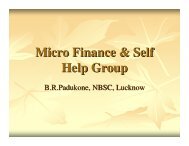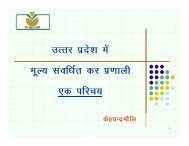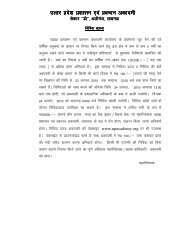A Primer on Microfinance - UP Academy
A Primer on Microfinance - UP Academy
A Primer on Microfinance - UP Academy
- No tags were found...
You also want an ePaper? Increase the reach of your titles
YUMPU automatically turns print PDFs into web optimized ePapers that Google loves.
A <str<strong>on</strong>g>Primer</str<strong>on</strong>g> <strong>on</strong> <strong>Microfinance</strong>U. B. DesaiSPANN Lab.Dept. of EEIIT-Bombaywww.ee.iitb.ac.in/~ubdesai
Some Basic Questi<strong>on</strong> Why do we need finance? Why the special need for finance for theunderserved communities? Why do poor still go to unorganized financialinstituti<strong>on</strong>s (m<strong>on</strong>ey lenders, shaukars, , ...)?Oct 2008 IT 625: ICT4SED2
Why is the spread of microfinance soslow? Why are commercial banks hesitant toenter microfinance?Oct 2008 IT 625: ICT4SED3
Some Basic Questi<strong>on</strong>Why do we need finance?credit is an instrument for investment and growth.Why the special need for finance for the underserved communities?Same as aboveShift in Perspective: From poverty alleviati<strong>on</strong> to wealth generati<strong>on</strong>---microfinance will enable wealth generati<strong>on</strong>Why do poor still go to unorganized financial instituti<strong>on</strong>s (m<strong>on</strong>eylenders, shaukars, , ...)?We will look at this during the talkWhy is the spread of microfinance so slow?Commercial financial instituti<strong>on</strong>s are not ready to enter this arenaWhy are commercial banks hesitant to enter microfinance?We will explore this in the talkOct 2008 IT 625: ICT4SED4
General Belief Poor are too difficult to reach. Small loans to poor is not a financiallyviable propositi<strong>on</strong> Financial instituti<strong>on</strong>s will loose m<strong>on</strong>eywhen they give microcredit to the poor Microcredit or microloans will <strong>on</strong>ly increasethe debt burden for the poorDo you agree? What is your opini<strong>on</strong>?Oct 2008 IT 625: ICT4SED5
<strong>Microfinance</strong> (mFI(mFI)A clever scheme forsmall-savings savings and small-loan for the underservedcommunityA financial service for thepoorA financial approachempowering the poor<strong>Microfinance</strong> brings inincremental changesIt does not bring indramatic changes like the<strong>on</strong>es that occur when acompany goes in for anIPO<strong>Microfinance</strong> may also bec<strong>on</strong>sidered a tool to givepoor people theopportunity to participatefully in ec<strong>on</strong>omic lifeWill improve the villageec<strong>on</strong>omyFacilitate increase in cashflowBring more villages into themarket; m<strong>on</strong>etize morevillagesHelp generate trade thrumicro-enterprisesOct 2008 IT 625: ICT4SED6
<strong>Microfinance</strong>: Interplay Am<strong>on</strong>g .. Instituti<strong>on</strong>s: Access points for the poor to get financial services(e.g. SEWA, Grameen Bank, etc.) These could be bank branches (could be virtualbranches), socially oriented financial instituti<strong>on</strong>s, or apartnership between the two Funding Sources: Domestic savings (~70%),“private socially resp<strong>on</strong>sible citizens” (~30%) Infrastructure: Here ICT can play a major roleOct 2008 IT 625: ICT4SED7
Unorganized mFI Instituti<strong>on</strong>s (mFI(mFI)Exorbitant interest ratesOn the low end 3% per m<strong>on</strong>th(36% per annum)can be much moreOften collateral, like cattle,jewelry, etc not returnedOften the poor get into a debtcycle for life!UmFI does not give loans forsustainability (for e.g. startinga micro-enterprise!)Oct 2008 IT 625: ICT4SED8Still the poor approach UmFI ---- Why?Always available (always <strong>on</strong>!)You get it when you reallyneed itQuick disbursementNegligible transacti<strong>on</strong> timePoor go for micro-loans justbefore they really need itLoans without collateralDependence of low-incomehouseholds <strong>on</strong> informalsources for loans is nearly 78per cent.The poor not <strong>on</strong>ly has low income but irregular cycle of paymentsand withdrawals. The informal financial instituti<strong>on</strong>s (m<strong>on</strong>ey lenders)satisfy this need to the tee
UmFI: : Case of Solapur District Collateral based lending Gold is typically the collateral Borrowers: small time officeclerks, pe<strong>on</strong>s, … people whohave permanent jobs Collateral amount is 1.5 timesthe loan value Loans taken for illness, familyfuncti<strong>on</strong>, etc. Interest is 3% per m<strong>on</strong>th Default rate 80% -- most ofthe time gold is c<strong>on</strong>fiscated About 100 lenders eachlending about a Rs.10 lakhs;totaling Rs.10 crs. Lending without collateral Interest rates are around 3%per m<strong>on</strong>th Repayment is <strong>on</strong> a daily basis Hawker, vegetable vendors willgo for such loans Often, most of the incomegoes in loan payment About 200 to 300 lenders inthis category Each loaning about 5 to 10lakhs Totaling about 20 crsOct 2008 IT 625: ICT4SED9
Some Facts There are an estimated 3,000 microfinanceinitiatives serving the world's poor scarcity of m<strong>on</strong>ey and participati<strong>on</strong> by commercialfinancial instituti<strong>on</strong>s has limited their expansi<strong>on</strong>. More than 70 percent of them serve fewer than 2,500borrowers each. Only 30 microfinance initiatives have grown toserve more than 100,000 poor borrowers. The largest mFI, Grameen Bank in Bangladesh,reaches more than 3 to 4 milli<strong>on</strong> borrowers. A total of $4 billi<strong>on</strong> has been disbursed sinceGrameen started giving loans in 1976 with seed loansstarting as small as $35.Oct 2008 IT 625: ICT4SED10
India …Earliest InitiativeShri Mahila SEWA (Self Employed Women’s s Associati<strong>on</strong>)Sahakari Bank was set up in 1974Since then, the bank is providing banking services to the poorself-employed employed women working as hawkers, vendors, domesticservant etc.SEWA bank has 1,75,000 depositors; about 70% from urbanarea, 30% from rural areasThe deposit and loan portfolio stood at Rs 623.9 milli<strong>on</strong>($13.86 milli<strong>on</strong>) and Rs133.6 milli<strong>on</strong> ($2.97 milli<strong>on</strong>)respectively.Though SEWA mFI is making profit, yet the SEWA bankmodel of mFI has not been replicated elsewhere in thecountryVery low default rateOct 2008 IT 625: ICT4SED11
India … Today, there are about 60,000retail credit outlets of theformal banking sector in therural areas comprising 12,000 branches of districtlevel cooperative banks over 14,000 branches of theRegi<strong>on</strong>al Rural Banks (RRBs(RRBs) over 30,000 rural and semi-urban branches of commercialbanks besides almost 90,000cooperatives credit societies atthe village levelOn an average, there is atleast <strong>on</strong>e retail credit outlet forabout 5,000 rural peopleWhile there is no publisheddata <strong>on</strong> private mFIs operatingin India, the number of mFIs isestimated to be around 800. Not more than 10 mFIs arereported to have an outreachof 100,000 microfinanceclients. An overwhelming majority ofmFIs are operating <strong>on</strong> asmaller scale with clientsranging between 500 to 1500per mFI.Oct 2008 IT 625: ICT4SED12
Target Populace for muF Rural Poor Women Asset value less than Rs. . 20,000/- Per capita income is less than Rs. . 350/-per m<strong>on</strong>th Live in poor housing c<strong>on</strong>diti<strong>on</strong>s(from SHARE <strong>Microfinance</strong> Ltd.)Oct 2008 IT 625: ICT4SED13
Different type of <strong>Microfinance</strong> Instituti<strong>on</strong>sInstituti<strong>on</strong>s that offers financial services to low incomepeople at the prevailing market rates.Most of these provide microcredit and accept small payments forsaving and repayment of loans.They do not take saving from the general public. They takesavings from their cliental – mainly the low income group.NGOs which are wholly involved in this or partly. The<strong>on</strong>es partly involved do several other work that is d<strong>on</strong>eby an NGO.Credit Uni<strong>on</strong>sPrivate commercial banksN<strong>on</strong>-bank financial instituti<strong>on</strong>sOct 2008 IT 625: ICT4SED14
Often <strong>on</strong>e classifies financial instituti<strong>on</strong>s like Nati<strong>on</strong>al Bank for Agriculture and Rural Development(NABARD) Small Industries Development Bank of India (SIDBI) Rashtriya Mahila Kosh (RMK)as mFIs; But, I feel ,they do not fit the bill, because theydo not cater to the kind of income talked aboutearlierOct 2008 IT 625: ICT4SED15
Appropriateness of mF mF works best for those who have identified anopportunity and the credit can be used to exploitthis opportunity to develop a sustainable sourceof income. <strong>Microfinance</strong> is not appropriate for Extremely poor, destitutes There has to be some viable way of micro-loanrepayment People who are extremely poor may get into debttrap with microfinance Numbers vary, but some feel that <strong>on</strong>e has to have98% loan repayments rate for an MFI to succeed.Oct 2008 IT 625: ICT4SED16
Some Data <strong>on</strong> Financial Sector in RuralAreas (2002)For 630,000 villages we have32,443 bank branchesOf the ~67,000 bank branchesin India, ~32,500 or ~48 percent are in rural IndiaThe average populati<strong>on</strong> servedby a rural bank is approx.15,000Overall, 18 per cent of therural populati<strong>on</strong> has bankaccounts. The comparativefigure in urban Indiais almost 100 per centThe per capita deposit in ruralareas is Rs 2,000Dependence of low-incomehouseholds <strong>on</strong> informalsources for loans is nearly 78per cent.Oct 2008 IT 625: ICT4SED17
Share of Different Sectors in GDP(GDP at factor cost, 1993-94 Prices)Rs. In croresAgri.IndustryServicesTotalServices%1970-711373204615111343829627838%1980-811592937068717114840112843%1990-9122311415038331937469287146%2000-01285877263797649011119868554%2001-02302054272359691016126542955%2002-03292625288266739842132073356%-- RBI, Handbook of Statistics <strong>on</strong> the Indian Ec<strong>on</strong>omyOct 2008 IT 625: ICT4SED18
Breakup of Indian GDPGDP for India: $1000 billi<strong>on</strong> 12 th largest in the word Approx. 4000 billi<strong>on</strong> base dpn PPP Rural GDP: ~$250 billi<strong>on</strong> (25%)Compare this withIT industry, which is~ $ 20 billi<strong>on</strong>22%56%22%Oct 2008 IT 625: ICT4SED19
Credit to Deposit (CD) Ratio for banks in India• Rural CD ratio needs to brought upto 60%• Low CD ~ a lot of cash is idling, or cash collected in rural areas is usedto give credit to urban areasOct 2008 IT 625: ICT4SED20
Different Financial Services under<strong>Microfinance</strong> Deposit services Credit lines Term loans M<strong>on</strong>ey transfers Micro-Crop and life insurance Micro health insuranceOct 2008 IT 625: ICT4SED21
Innovati<strong>on</strong> in <strong>Microfinance</strong> Development of finance products for theunderserved Management of credit risk (minimizati<strong>on</strong>losses in giving credit) Scalability: how to reach a vast, diverse,not easy to reach and geographicallyscattered populace Efficient delivery of microcredit exploit technologyOct 2008 IT 625: ICT4SED22
Gautum Ivatury:Focus Notes, Jan 2006, CGAP(C<strong>on</strong>sultative Group toAssists the Poor)www.cgap.orgOct 2008 IT 625: ICT4SED23
Microcredit Delivery of microcredit has to be d<strong>on</strong>e more andmore efficiently Here ICT can play a major role Determinati<strong>on</strong> of a borrower's willingness andability to repay a loan is critical if a microlenderis to minimize credit risk Willingness to repay a loan are complex anddetermined by ec<strong>on</strong>omic, legal and moral incentives Legal systems and community pressure (for rural areas)c<strong>on</strong>tribute to a borrower's willingness to repay a loan Ability refers to a borrower having the financialresources to make a scheduled loan payment.Oct 2008 IT 625: ICT4SED24
Three operati<strong>on</strong>al areas <strong>on</strong> which amicrolender should focus to minimizecredit risk: loan design underwriting loan servicingOct 2008 IT 625: ICT4SED25
Micro-Loan DesignBalance between affordability needs of borrowers andcosts to micro-lendersRevolves <strong>on</strong> the design of interest rates (must(cover operatingcosts, credit risk and funding costs)Interest are very critical to microfinance instituti<strong>on</strong> mFI interest are not very low at present 15% to 36% per annum (SEWA charges 15% to 18%) Note: RBI interest ceiling is 21%On the other hand, for rural poor, it has been observedthat the amount of m<strong>on</strong>thly payment is much moreimportant than interestAs l<strong>on</strong>g as they are comfortable with the scheduled paymentamount they do not worry too much about interest ratesOct 2008 IT 625: ICT4SED26
Micro-loan Underwriting The process of determining a borrower'scredit worthiness ability and willingness to repay a loan Most important from the microlender’spoint of viewOct 2008 IT 625: ICT4SED27
Micro-Loan ServicingLoan servicing is the act of collecting payments and maintaining thebalance of a loanIn commercial banking, loan payments are made by bank draft or by bdirectly debiting payroll or a bank account.Things are not easy in the world of microfinance.The typical borrower does not have access to a bank account and oftendoes not receive a formal salary.This means that for many customers of microlenders making loanpayments can be difficult and put them in the positi<strong>on</strong> of making thechoice to take time off from work (and possibly get fired) in order todeliver a loan payment or choose not to make a payment.Successful lenders will set up payment kiosks in communities. Thekiosks are typically open before the typical work day starts and after itends.Another effective method, albeit more labor intensive is door-toto-doorcollecti<strong>on</strong>s.Oct 2008 IT 625: ICT4SED28
Micro-Loan Servicing …Provide positive incentives for payment.Borrowers resp<strong>on</strong>d well to positive incentives for good paymenthistory.Microlenders and mortgage lenders have successfully usedincentives such as payment rebates, small appliances and foodto achieve very high levels of repayment.For example, <strong>on</strong>e Mexican lender offered a free bag of corn mealif a borrower made timely payments for six m<strong>on</strong>ths. The resultwas a delinquency rate of less than 1%Be proactive in dealing with delinquencies.Rather than wait until a loan goes into default, a microlendershould investigate a loan within weeks of it first becomingdelinquent.Often, the cause of a delinquency is due to illness orunemployment.If caught early enough a lender can give the borrowerassistance as well as workout a equitable repayment plan.Oct 2008 IT 625: ICT4SED29
ChallengesEstablishing the idea of access to financial services ashuman right; just like health care, educati<strong>on</strong> etc. arebasic rights (Mathew Bishop, Business Editor of TheEc<strong>on</strong>omist)Managing credit risks in microlending operati<strong>on</strong>sC<strong>on</strong>vincing, for profit organizati<strong>on</strong>s like establishedbanks, n<strong>on</strong>-bank financial instituti<strong>on</strong>s, that microfinanceis a good business opportunity and they should commitlarge capital to establish this business.Also c<strong>on</strong>vincing them that charity (funds d<strong>on</strong>ated by establishedorganizati<strong>on</strong>) is not a sustainable way for growthDeveloping a market driven interest rate schedule forthe poorOct 2008 IT 625: ICT4SED30
Challenges …Reaching people in sparsely populated, diverse, not easy to reach,and geographically scattered areasLast mile problem of reaching the rural poor.Most important challenge is to exploit technology to reducetransacti<strong>on</strong> costs so that financial instituti<strong>on</strong>s will indeed take e upmicrofinance as <strong>on</strong>e of their major service.Reaching the poorest of the poor – the destitute:Many ignore this segmentVery difficult for a commercial instituti<strong>on</strong> to recover micro-credit credit givento this segmentHere Government will have to step n develop a scheme for micro-grantsMake microfinance part of main stream financial marketData Collecti<strong>on</strong> – need to collect data that can indicateOct 2008 IT 625: ICT4SED31
One Approach exploiting ICTRural ATMProviding ICT based Rural Banking• Developed by the TeNetgroup of IIT-Madras• To be deployed in village kiosksin collaborati<strong>on</strong> with ICICI bank• Low cost rural bank• Deposits, withdrawal, and loans• Cost of rural ATM: Rs40,000/=• C<strong>on</strong>venti<strong>on</strong>al ATM costs:Rs.7,50,000/=• Uses extremely low cost fingerprint authenticati<strong>on</strong> system(Rs.50/=)• Use of plastic ID cards “smart orotherwise” not viable in ruralareasOct 2008 IT 625: ICT4SED32
Another Approachexploiting ICTExploit Cell-ph<strong>on</strong>e,Smart-Ph<strong>on</strong>e PlatformGrowing at a phenomenalpace 300 mil cell ph<strong>on</strong>es Cost of deployment inurban areas:Landlines – Rs.20K per lineCellular --- Rs. . 3K to 3.5Kper lineAnnual business ofhandset reachingRs.10,000 crore ($220mil), , comparable to colortelevisi<strong>on</strong>s – indicatingaffordability.7-99 mil new c<strong>on</strong>necti<strong>on</strong>sacross the country everym<strong>on</strong>thOnly ~20 mil PCs in IndiaOct 2008 IT 625: ICT4SED33
<strong>Microfinance</strong> is a necessary inputfor rural wealth generati<strong>on</strong>but by no means sufficientOct 2008 IT 625: ICT4SED34
Oct 2008 IT 625: ICT4SED35



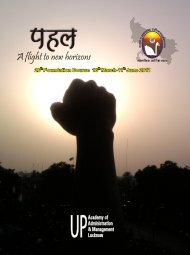
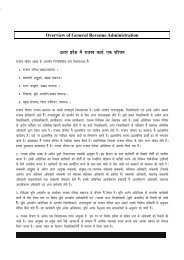
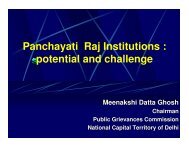

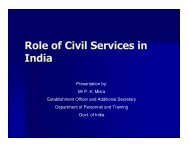
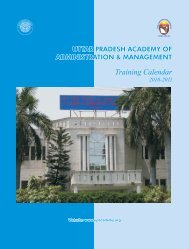
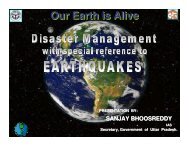


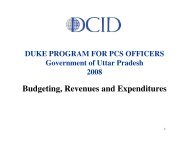
![m0iz0 iz'kklu ,oa izcU/ku vdkneh] - UP Academy](https://img.yumpu.com/32257946/1/190x245/m0iz0-izkklu-oa-izcu-ku-vdkneh-up-academy.jpg?quality=85)
